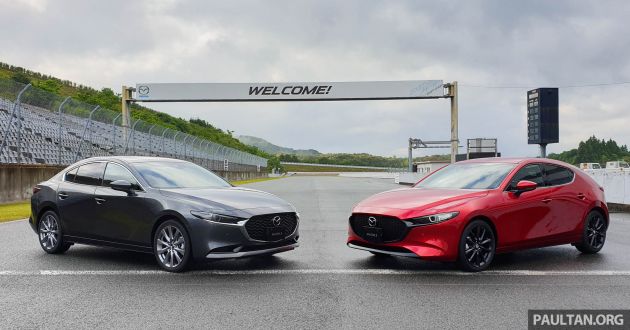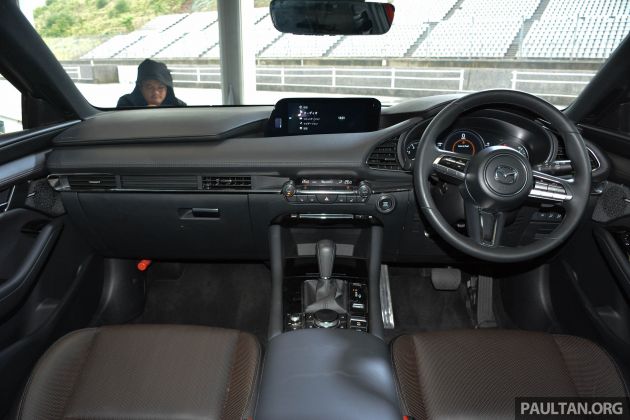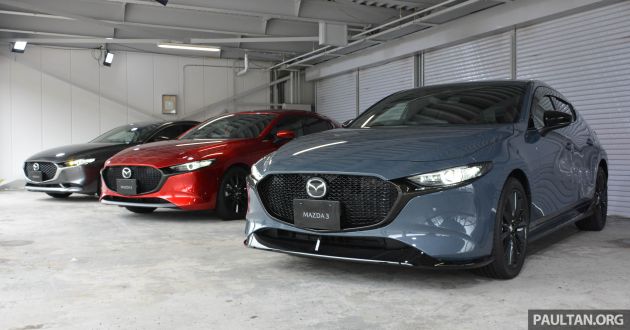We’ve spoken a great deal about the latest Mazda 3 in our previous post(s), and now it’s time to share our first impressions of the model, which will be launched in Malaysia in about a month’s time. The new car is a big deal for Mazda, as it is the first in the company’s next-generation product line-up that also includes the CX-30.
As you’ve gathered from our most recent technical breakdown piece, a lot of effort has been made to remedy an issue that is commonly associated with the outgoing model: NVH. That’s not all, as the company still needs to maintain its reputation for designing cars that are visually striking in terms of both exterior and interior design – the latter now with more practical considerations.
These measures are necessary as the company aims to further distinguish itself as a more upmarket brand compared to other carmakers such as Honda and Toyota, which command a significantly greater market share; look at the Japanese car sales figures for 2018 and you’ll see Mazda in sixth place (220,743 units), behind first-placed Toyota (1,508,647 units) and Honda (747,226 units) in second place.
So, does the Mazda 3 deliver on the company’s promises? Well, we had the opportunity to sample the direct rival to the Honda Civic and Toyota Corolla Altis at the Mine Circuit in Japan, one of several proving grounds that Mazda uses to test its vehicles. Read on the find out.
Our drive programme didn’t provide us with a lot of seat time, as we were given just two laps on the track itself, followed by another two rounds on a closed road circling just outside the track grounds. On both stints, we were given the chance to try the new and outgoing model back-to-back, although we did have to follow behind a pace car for safety reasons. The wet weather on the day meant the speeds we were reaching were kept in check as well.
That didn’t give us many avenues to fully test out the Mazda 3’s new rear torsion beam, which replaces the outgoing model’s multi-link setup. Yes, the “fancier” suspension is now gone, but Mazda believes that its patented torsion beam design that differs from the current Mazda 2 and CX-3, reaps more benefits, particularly when it comes to NVH.
Despite the restrictions, our time on track did reveal the new Mazda 3 to be a well-composed car, with relatively neutral handling characteristics. There’s a progressive loading of the suspension here, accompanied by some body roll, although not to the point that it becomes worrying.
Steering feel is rather muted given the electrical assistance, but the lightness of it is welcomed for the city, where the Mazda 3 will likely spend most of its time. There’s also enough precision here to accurately place the car through corners, and the wheel itself has a relatively thin rim – though I wish it was slightly smaller in diameter.
Given the generally low speeds we were doing, it’s hard to determine how the new suspension setup will react when placed under more demanding driving loads. Additionally, the buttery smooth track tarmac didn’t help in any way to examine how the car dealt with uneven and bumpy terrain i.e. the roads of Petaling Jaya.
A tour of the “winding road” course did introduce the Mazda 3 to a section of “rough road” later on, although the condition of this small bit of terrain can be considered child’s play compared to what we have in our country. The car did soak up the “bumps” without fuss on this particular section, but I think a fairer assessment can only be made when we get a local unit to test for ourselves.
I can however validate Mazda’s claim of improved NVH with the new car, as there is a perceptible reduction in road and wind noise in the latest model when compared to the previous one. Less vibrations were also felt through the seats and steering wheel, which is a good sign that those new damping nodes within the vehicle frame are doing their job.
On the mention of the seats – part of Mazda’s SkyActiv-Vehicle Architecture – they provided good support, with sufficiently thick bolstering on the sides to keep me in place during tighter hairpin sections. I will say that those with larger body sizes might find it a little more challenging to get into them, as they do provide a rather snug fit.
The engines found in our test vehicles, which included the third- and fourth-gen models (some being pre-production cars), all featured a 2.0 litre four-cylinder petrol unit from Mazda’s SkyActiv-G range, along with a six-speed SkyActiv-Drive automatic transmission and front-wheel drive.
These engines aren’t indicative of what we’ll get here, as the third-gen cars are GCC-specced, while the fourth-gen follows North American specifications. In the case of the former, the unit makes 153 hp and 200 Nm of torque, while the newer units serve up 155 hp and 203 Nm. Updates that were made with the fourth-gen’s mill include new intake ports and piston shape, split fuel injection, and a coolant control valve that are claimed to provide better performance and fuel economy.
In practice, the new 2.0 litre unit retains the familiar punchy feel as its predecessor, with most of the power being available in the mid-range up to 4,000 rpm. It’ll easily get up to most speed limits with ease, and the engine welcomes rev-happy individuals, with peak horsepower arriving at 6,000 rpm.
For our part of the world, we will get a 2.0 litre petrol unit that develops 162 hp and 210 Nm of torque. Meanwhile, the option for base variants will be a 1.5 litre powerplant with 114 hp and 150 Nm; both engines get an automatic gearbox.
Sadly, there was no chance to try the 1.5 litre engine, which is one of the offerings for Malaysia, nor was there a SkyActiv-X-equipped car available to us. The only time our publication has had any contact with the latter was back when our sister site paultan.org/BM had the chance to sample prototype back in June last year – you can read about it here.
Away from the track and “winding road,” Mazda also had a unique demonstration prepared to showcase the Mazda’s 3 new platform, specifically in the way the energy is transmitted in smoother fashion compared to previously.
The setup involves the third- and fourth-gen models, with both cars having their front passenger seats removed. In their place is a custom seating device, where a formed cushion is fixed over a rotating ball mount. This is meant to force the passenger to sit with an upright posture to maintain balance – one of the key principles of the platform – while the car is driven at a slow pace not exceeding 5 km/h.
Although the speed is comical, I discovered that it took less effort to maintain my balance in the new car compared to the previous one in back-to-back runs. Mazda says this serves to illustrate the development work that has gone into its new platform, which in turn makes it less fatiguing for the human body when driving over long distances.
Distancing away from the driving sessions of the day, what’s the new car like to live with? Well, for starters, the interior of the new Mazda 3 exudes a premium feel more akin to what you might find in cars higher up in the luxury segment.
The fit and finish of the cabin was good, and is complemented by the use of materials that felt pleasant to the touch. The attention to detail even extends to the buttons and switches, which Mazda says are unified to ensure a consistent operation feeling each time they are used.
A more minimalistic dashboard design is aimed at reducing “visual noise” that may pull your attention from the task of driving. As such, the top dash is largely devoid of anything, including speakers, with just acres of soft-touch material in place. The positioning of the infotainment screen further away from the driver is also deliberate to maintain driver focus, as compared to the in-your-face display tablet found in the third-gen.
It isn’t just looks where the interior is better, there are practical improvements as well to make the Mazda 3 a lot easier to live with on a daily basis. That rather puny storage area ahead of the gear lever in the previous car is now more cavernous, and the cupholders (now with a lid) have been brought forward to add to the available stowage space. The latter is meant to encourage better ergonomics, and this ideology is also applied to the gear lever that is now slightly higher for easier reach.



Ditto the command controller for the Mazda Connect infotainment system, which now has a simpler and more intuitive layout so there’s less faffing about trying to look for the right button to press. It’s now just a main dial with four buttons surrounding it, while forward/back is part of the volume dial – simple.
Fans of armrests will be glad to know that the one in the Mazda 3 is now much larger than before, and features a “karakuri” mechanism, whereby to open the centre lid is a two-stage process, as you’ll need to slide the lid back before it tilts upwards.
This is meant to make it less strenuous on your elbows, which is good, but I reckon many will attempt to directly lift the lid without sliding it back first on their first try. It’s something you’ll need to get used to, and will either be immensely appreciated or loathed.
As for the HVAC system, the controls are straightforward, and they occupy a smaller real estate compared to the triple-dial configuration of the past. Those dedicated vents for the driver and front passenger – though neat in design – might not distribute air as well to those in the rear, although we’ve been told rear vents will be available for our market.



Elsewhere, the new Mazda Connect system no longer gets a touchscreen, so you’ll only have the commander control for interfacing, but the revamped interface is cleaner and easier to navigate through. The crisp font type used also make for easy legibility, and this is also applicable for the instrument cluster that now boasts a seven-inch TFT-LCD display.
A slight irritation, in my opinion, is the need to use the rotary dial to cycle through characters to key in addresses for the navigation system. In the previous iteration of Mazda Connect (like in the current CX-5), touchscreen functionality allowed for easy text input, although it was only enabled when the vehicle is stopped. I suspect that most users will just opt to use Android Auto or Apple CarPlay instead, but keep in mind you can only navigate within each app using the commander control.
While there is a 25 mm longer wheelbase with the new model, rear-seat space is still somewhat limited in my opinion. For my 170-cm stature, there is enough room for my knees and about four and a half fingers worth of headroom to spare, but it may be a concern for taller humans.
The bold C-pillar design and upswept window line on the hatchback also meant a slightly claustrophobic feel while seated on the rear bench, although this is less of a problem when it comes to the sedan that has a more generous amount of window area.
At the rear of the car, the adoption of the torsion beam suggests a more generous amount of boot space, but this is only the case for the sedan, which now stands at a VDA-rated 444 litres (+36 litres) compared to its predecessor. Curiously, the hatchback’s cargo capacity is now less at 295 litres, 13 litres down from before (308 litres).
However, the shape of the cargo space, even with the intruding wheel arches, does seem to suggest that taller items will be less of a hassle, and you still have a 60:40 split-folding rear bench if you need more space. Depending on what you intend to lug around (and how frequently), this could be a hit or miss aspect of the car.
Compared to the previous Mazda 3, the new car earns brownie points by providing a much more pleasant driving experience thanks to the NVH improvements. The handling and ride comfort qualities of the car are still up for debate until we get one in our local environment, but early impressions are rather promising (for now).
The interior is still a plus point in my book, as its premium look and feel clearly punches above its own weight when compared to rivals in its segment. Efforts to provide better ergonomics and practicality are welcomed, but the matter of space involving rear passengers and the boot is still very much questionable.
All in all, the new Mazda 3 represents a major step forward for the model, and those who prioritise the Jinba-ittai driving experience in a “posh” cabin can look forward to a good time behind the wheel. This is car that deals in absolutes, in that you’ll either understand its concept completely, or dismiss entirely. Best to try it out for yourself before settling on a decision.
With estimated pricing said to start at RM137,000, do the improvements, as well as the premium look and feel of the new Mazda 3 justify its price?
Source: Read Full Article













